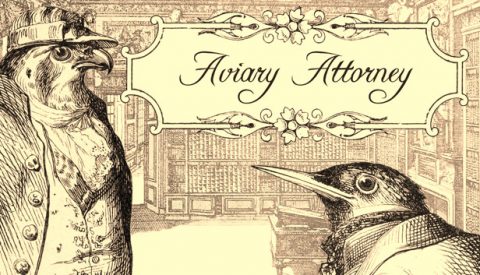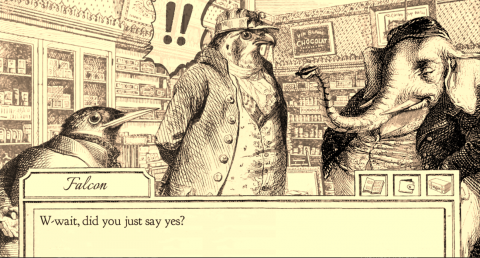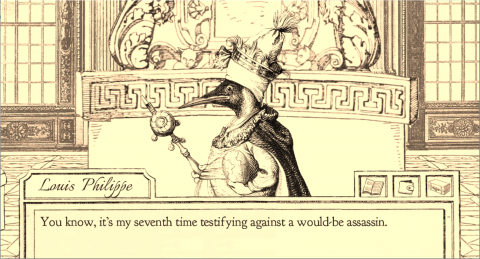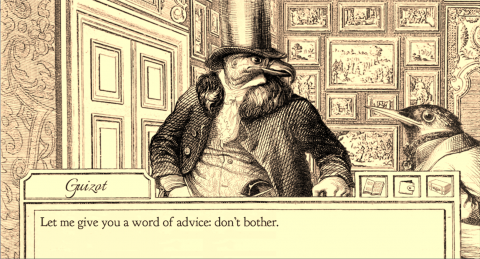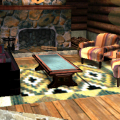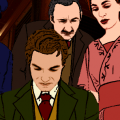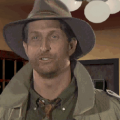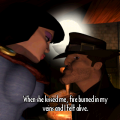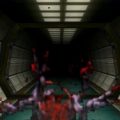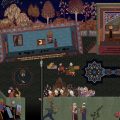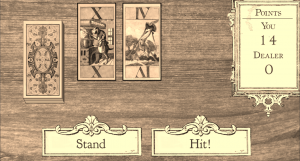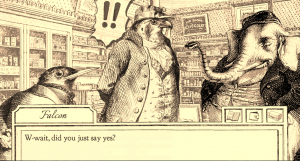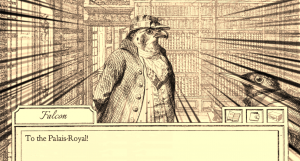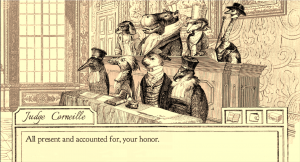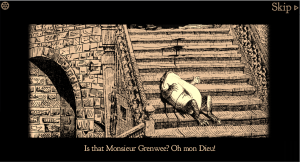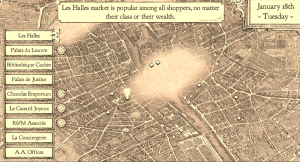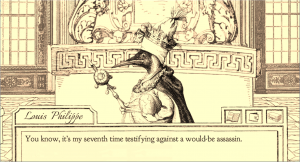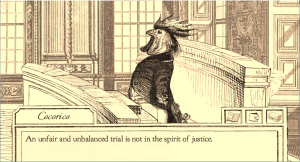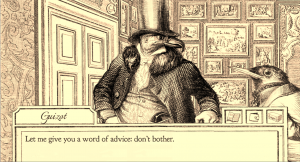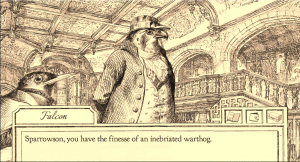You may already know about the French Revolution, but you may not have realized there were actually several French revolutions. The one related to Bastille Day was in 1789, and saw monarchy replaced by democracy (and the Guillotine). This experiment came to a halt in 1799, when Napoléon took power and the French Empire waged war in much of Europe. In 1814, Napoléon was exiled, and it was back to a monarchy; but people enjoyed having a say in society and laws, and a revolution happened in 1830 when the king attempted to restrict civil society too much. This led surprisingly to another monarchy, but with a king, Louis-Philippe, who wanted to appear close to the people; under his rule, trade and industry prospered, but rising income inequality and the suppression of political meetings triggered the 1848 revolution, which saw the French do away with monarchy once and for all.
Aviary Attorney takes this crucial moment in French history as a backdrop, and uses it very deftly to touch on heavy topics about justice and politics. It is also, well, Ace Attorney with birds, and despite a few problems it is a very good game.
The gameplay is extremely similar to the Ace Attorney series, which is a good thing if you like that series. As the defense attorney Jayjay Falcon, you have to deal with four cases, and they progressively are linked together, while the final case provides a resolution to the overarching story. You start with an investigation phase, where you explore locations to find clues (by examining different parts of the background), and gather information by talking to people, including suspects and witnesses. Important information and clues are added to your inventory, in preparation for the trial sections. In these sections, you need to cross-examine the prosecution’s witnesses by reviewing their statements and choosing to dig deeper for some of them; of course, you’ll need to present evidence to back up your claims, and show that other theories are possible. The goal is ostensibly to get a “not guilty” verdict, and the prosecutor you’re facing is very talented and obnoxious. This is standard fare for the fans of the Ace Attorney series, although these courtroom sequences are not as good here: they are much shorter, with at most 3 or 4 cross-examinations, fewer twists and turns, and most of the gameplay is spent investigating instead. It takes about 6-8 hours to 100% the game, which is slightly less than a standard Ace Attorney episode.
There is also a big difference in approach: Ace Attorney has a linear story, where each trial must be won or it’s Game Over, and as a consequence the game will not let you start the trial without all the evidence you need to progress. In contrast, Aviary Attorney‘s position is that the story must go on, whether you win or lose the trial; victory is not the only way. This is emphasized in the first trial, where a twist makes you question the victory and your courtroom tactics. In subsequent trials, the game’s approach is to limit the time you have to gather evidence: most locations you need to visit will take up one day of your time, and you have, say, 10 days before the trial. The number of locations can be large, some clues or conversations only unlock if you’ve done something else instead, and some locations turn out to be a waste of time; this means, in my experience, that it takes luck to get it right on the first try. If you have an Ace Attorney play style, you will be frustrated at the game for leaving you so little time (or wasting it) and making you enter trials when you’re not ready; if you have a more relaxed play style, you might appreciate the fact that, contrary to Ace Attorney, you will never get stuck on a particular deduction or leap of intuition you can’t figure out. This approach can take some fun out of the courtroom scenes, because at any moment you can get stuck because of choices you made 20 minutes ago. Fortunately, should you still have the compulsion to solve it all, the game makes it very easy to go back to a previous point in the game; the investigations are separated in “days”, and you can go back to any day you want. (Let’s also mention here that, while the game tells you you can save any time, this is not true; loading always takes you back to the beginning of the day.)
However, one massive benefit of this approach is the fact that it allows the story to branch, in ways Ace Attorney never did. The way the game sets this up is neat: at the end of Act 3, at a point where the stakes are very high, you can decide to be quiet, or speak up and trigger a trial (which you can win or lose). The fourth and final case will then be totally different, labeled 4a, 4b, or 4c. (When it was first published on Steam, Act 4c was not written, with just a “coming soon” message; the author finished writing it reasonably quickly, but it left a sour taste in some players’ mouth). All three cases happen as the 1848 revolution starts, but their tone, goals and characters are different. This allows the game to explore several aspects of the revolution, and it does it very nicely; the writing in Act 3 and 4 really shines, and just like in an Ace Attorney game, they are the best parts of the game. All three branches of Act 4 are worth exploring, but once again, one of them can only be accessed by winning the trial in Act 3, which means you need to replay Act 3 until you get have the clues in hand before that sequence triggers; this is facilitated by save points, but is still reliant on you not wasting time and asking the right questions on the right day, which requires trial-and-error and isn’t the most fun.
The all-animal cast is on the surface very clever marketing, as it gives a very striking visual pitch, and reminds people of Hatoful Boyfriend; both games do belong to the “metamodernism” category, but the similarities stop here. There’s a more practical side to this: it allows the author to mostly use public domain art. (The same technique was used in the point-and-click “Four Last Things”.) The artist is JJ Grandville, a 19th century caricaturist from Nancy, France. Grandville became famous with his caricatures depicting animals with human bodies, which are wonderfully drawn, and inspired both his contemporaries and future generations of artists like the surrealists. Grandville drew thousands of these caricatures, with a biting wit; his targets were public figures, the Church, and the French monarchy. He actually got in trouble with authorities, with the police ransacking his house, and a law requiring caricatures to be vetted by the authorities, voted after he became popular. Grandville is thus a very interesting figure of an artist standing up to power, and its political bent definitely influences the game.
Picking Grandville’s caricatures to create the characters probably still took a lot of time to choose the characters and properly scan them. The developers did a very good job, as the quality of the graphics is very good, with no discernible artefacts; the Switch version, released only last year, has higher-definition scans that look even better. A few of the pictures, such as some backgrounds or exposition scenes, are not taken from Grandville, but rather drawn for the game; they keep the same style and do not look out of place at all. What’s more, there are graphics embellishments that make the whole thing come to life: all the characters move their mouth when they talk, scared characters (e.g. witnesses at the stand) are visibly sweaty, and the movement of the bodies is extremely expressive. Other VNs often have character sprites that look at the player straight-on, with a shot/reverse shot approach and barely any movement; this game shows all the characters on the screen at the same time, as they turn to each other, move closer or away, etc. Just like in a play, or a puppet show with animal cutouts if you prefer, but animated with minutiae and an incredible sense of comedic timing – the game made me laugh out loud a few times just by moving the sprites a certain way.
Because, yes, Aviary Attorney is a very funny game. There’s a lot of humor and spirit in the game, and it manifests in different ways: there’s physical comedy, puns (some more groan-inducing than others), pop culture references, fourth wall breaks, witty banter, farce, etc. The jokes come at a good pace, too, never overwhelming but fairly frequent; besides, they are well-written, and rarely come across as the author trying too hard to be funny. This is probably thanks to extremely well-written characterization, and a very diverse cast of characters. Most of them are birds: Jayjay Falcon, the defense attorney with a secret past; Sparrowson, his energetic and dedicated assistant; Séverin Cocorico, the talented prosecutor much like Miles Edgeworth; Inspecteur Volerti, the proud and gruff head of the Parisian police; and the king, Louis-Philippe. But you will also encounter crocodiles, elephants, kangaroos, lions, giraffes, and rabbits, each with a very distinct voice. The humor often flows naturally from the interactions between characters and their archetypes; this is of course partly thanks to the quality and expressiveness of Grandville’s work, which also tended to use familiar archetypes. The personalities are furthered by the choice of music, which is taken from public domain as well: “Le Carnaval des Animaux”, by 19th century composer Camille Saint-Saens, an orchestral piece in which each song is meant to evoke an animal (a very good piece of classical music, and a staple of French kindergarten). Their use along with Grandville’s images works very well to create striking characters; but that’s not to discount the quality of the writing. The strong characterization allows the game to create heavier moments, and it doesn’t shy away from that; a particularly good example is the relationship between Jayjay and Sparrowson, which is deeper than your standard “great hero with a bumbling sidekick”, and makes you care about both equally, especially in tough times.
What’s interesting, too, is how well the story uses its historical backdrop. Its depiction of 19th century Paris is faithful, using places like the Conciergerie prison, the Halles market, the Palais Royal, and the Louvre. What’s more, its depiction of society is also very good, and it doesn’t shy away from the politics of the time – the fact that Grandville’s animals were meant to depict precisely that likely helps. The 1848 revolution happened because of rising income inequality, with the bourgeoisie (investors, business owners, etc.) reaping the rewards of the Industrial revolution while the poor didn’t; this fostered unrest vis a vis the rich (a cigar-smoking lion in the first case of the game), the powerful Church (a wolf), and the King (a foolish bird). In the game, the way these characters are depicted resonates with this sentiment, in a way that helps the player understand that a revolution is inevitable. This sets up the endgame beautifully; the high stakes, the faithful depiction of political troubles, and strong characters all come together to touch on topics like revolution, terrorism, justice, radicalization, political transitions, and the transformative and healing power of trials. None of these themes are heavy-handed, but rather appear as a natural consequence of the historical backdrop and the characters, which is great.
The game came out for Windows on Steam in 2016, and had a Switch re-release in 2020; the Switch version has the same content, but boasts higher-quality scans of the animals and a better, in my opinion, parallax effect that allows the characters to stand out more against the background compared to the Windows version. The Switch version also adds more art and a jukebox, alongside the story, as well as some achievements.
Aviary Attorney is a very good addition to the genre, worth checking out even if you do have never played Ace Attorney, as the excellent writing, humor, and presentation makes it worth it – if you’re willing to adapt to its gameplay choices and its short length.

